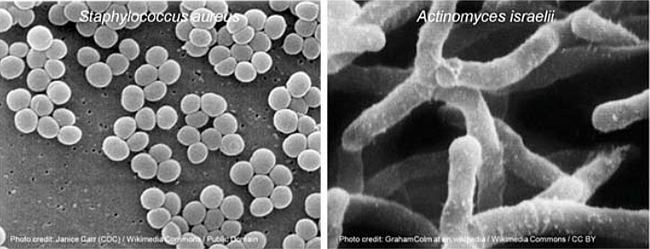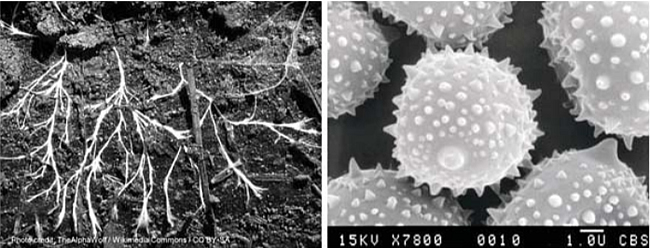Soil microbes – bacteria, archaea, and fungi
Soils harbour enormous microbial diversity, comprising bacteria, archaea, and fungi. The total fresh weight mass of organisms in grassland soils can exceed 45 tonnes per hectare, equalling or exceeding above-ground biomass.
Bacteria are present in greatest numbers, with archaea 10-fold less. The numbers of species of bacteria per gram of soil have been estimated to range from 2000 to 18 000. Fungi, however, often contribute the largest part of the total microbial biomass in soils. The activities of soil microbes drive or contribute to the cycling of all major elements (e.g. C, N, P), and this cycling affects the structure and functions of soil, as well as the ability of soils to provide ecosystem services.
What are bacteria, archaea, and fungi?
Bacteria and archaea are the smallest independently- living, single-celled organisms on earth. Typical cells range from 0.5 to 1.0 μm in diameter. Bacteria and archaea may occur as cocci, rods, or spirals, and some bacteria common in soils, such as the Actinomycetales, can form branching fi laments (Figure 1). Most lack a true membrane-bound nucleus, so their DNA lies free in the cell cytoplasm. Their genome typically consists of a single circular molecule of double-stranded DNA. A cell membrane made of phospholipids surrounds the cell. Outside this is the cell wall, usually made up of proteins, carbohydrates and lipids. Many microbes can move, using flagella (whip-like extensions from the cell). They can also form fi ne fi laments called pili that can attach the cells to each other or to soil surfaces. Usually they undergo asexual reproduction, typically by dividing in half; some cells can divide every 12–20 minutes, while others take much longer.
 |
| Figure 1. Examples of the structure of bacteria. |
As with all organisms, bacteria and archaea require carbon to provide the building blocks for cell materials. They also require energy to drive the reactions involved in cell synthesis and metabolism. To grow, some bacteria require oxygen, while other bacteria and most archaea use alternative electron acceptors, including nitrate and sulphate (i.e. they respire nitrate and sulphate). For these anaerobic organisms oxygen may be toxic. Broadly, microbes are classed as autotrophs or heterotrophs. Autotrophs use energy from sunlight or inorganic compounds (e.g. Fe2+, nitrate or nitrite) to fix atmospheric carbon dioxide to produce carbohydrates, fats and proteins, whereas heterotrophs use organic carbon compounds as a source of carbon and energy.
Archaea were originally thought to exist only in harsh environments, but we now know they are widely distributed and are found alongside bacteria in many environments, including soil. Recently Archaea belonging to Crenarchaeota have been implicated in nitrogen cycling in soils. Archaea and bacteria are difficult to distinguish on the basis of their morphology. However, molecular phylogenetic tools that compare 16S ribosomal rRNA sequences have revealed that all life can be divided into three domains, with Archaea being more closely related to Eukarya (all multicellular organisms) than those two are to the Bacteria.
Fungi are eukarya and hence more closely related to plants and animals than to bacteria or archaea. Like all eukarya, fungal cells contain membrane-bound nuclei with chromosomes that contain DNA. They also have membrane-bound organelles such as mitochondria. Fungi have a cell wall composed of glucans and chitin. Fungi are heterotrophic organisms, and they feed on decaying matter. While some fungi occur as single-celled organisms, generally referred to as yeasts, many grow as hyphae, which are cylindrical thread- like structures, 2–10 μm in diameter (Figure 2). The hyphae may be either septate – divided into compartments separated by cross walls – or non-septate. Fungi grow from the tips of the hyphae. Many intertwined hyphae constitute a mycelium, the main body of the fungus. Finely and complexly branched, the mycelium occupies a large volume of soil and produces a wide variety of enzymes that act on soil organic matter and mineral compounds to release the nutrients and energy the fungus needs for growth. Fungi reproduce by both sexual and asexual means. Both processes produce spores, a general term for resistant resting structures. Yeasts reproduce by budding or binary fission.
 |
| Figure 2. Examples of (A) fungal hyphae in soil, (B) fungal spores. Photo credit for 2B Ronpast/Wikimedia Commons/CC-BY-SA/3.0. |
Jackie Aislabie — Landcare Research
